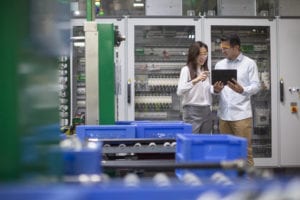A company like Schneider Electric has been involved with electrical distribution from the start. While that heritage is rich, the future is far more exciting.
Looking at companies that have long histories can be an interesting exercise in understanding adaptability. Those that have been around for a century or more have undoubtedly gone through changes that shook them to their cores. At the same time, history is littered with companies that couldn’t adapt and they’re gone.
Schneider Electric falls into the century plus category, which means it has been in operation for most of the period of commercial electrical generation and distribution. Sure, power is still delivered by wires and there is big switch gear, but some of the biggest changes involve much smaller items.
Xavier Datin is already working on that next chapter, which he characterizes as the “digital revolution.” While Google isn’t generating power commercially and Amazon doesn’t deliver electricity to homes (at least not yet in either case), that revolution is creating the Internet of Things and it is providing ways for utilities and residential customers to engage in much different ways. As Datin explains, you can’t have the IoT without the things, and Schneider Electric wants to be involved in creating and providing things that will help utilities engage with customers and help customers manage their electrical consumption.
There is little doubt that the IoT will see many trivial applications, or at least many applications that seem trivial now. (A few years back the thought of having a phone that could shoot video seemed pretty silly, but try to find one now that doesn’t.) Datin stresses the importance of having technologies that provide genuine value for a customer, contrasted against the uselessness of technology for the sake of technology.
Schneider Electric sees huge value in being able to connect all its applications in a way that supports free flow of data and information, but the underlying value has to be in meeting real customer needs. Mobility is a major element of that since it extends connectivity in many new directions. So what is the best way to put that to work? Schneider Electric’s Wiser home management products are a key example in that they use technology in a way that promises real value to users. Users in this case being both residential customers and utilities. Customers are able to control costs by avoiding consumption at peak cost times, and utilities can better manage peak demand.
This works because creating a product that is compelling for users gets engagement from the utilities. In the product design phase, Wiser did its homework making sure it created something that would be easy to use for many different kinds of customers. Any electronic device these days has to be intuitive and ready to work right out of the box. Few people, particularly younger ones, have any patience for manuals.
With the right technology, a utility can get the effect it wants while leaving customers to find their own way with the products. It doesn’t get any easier than that.



